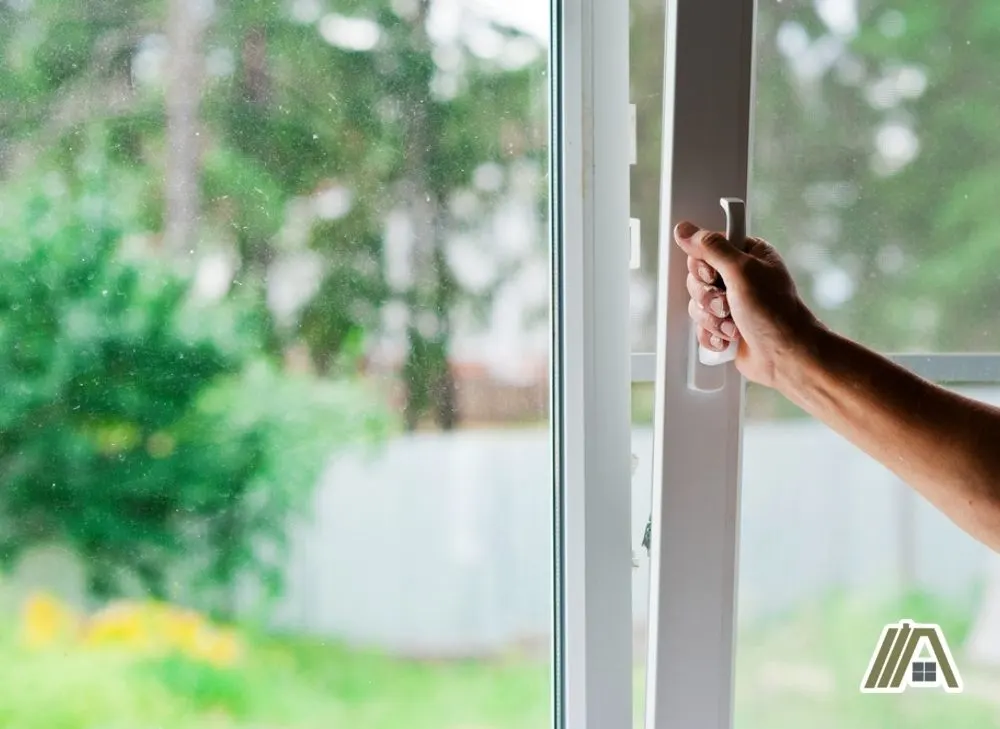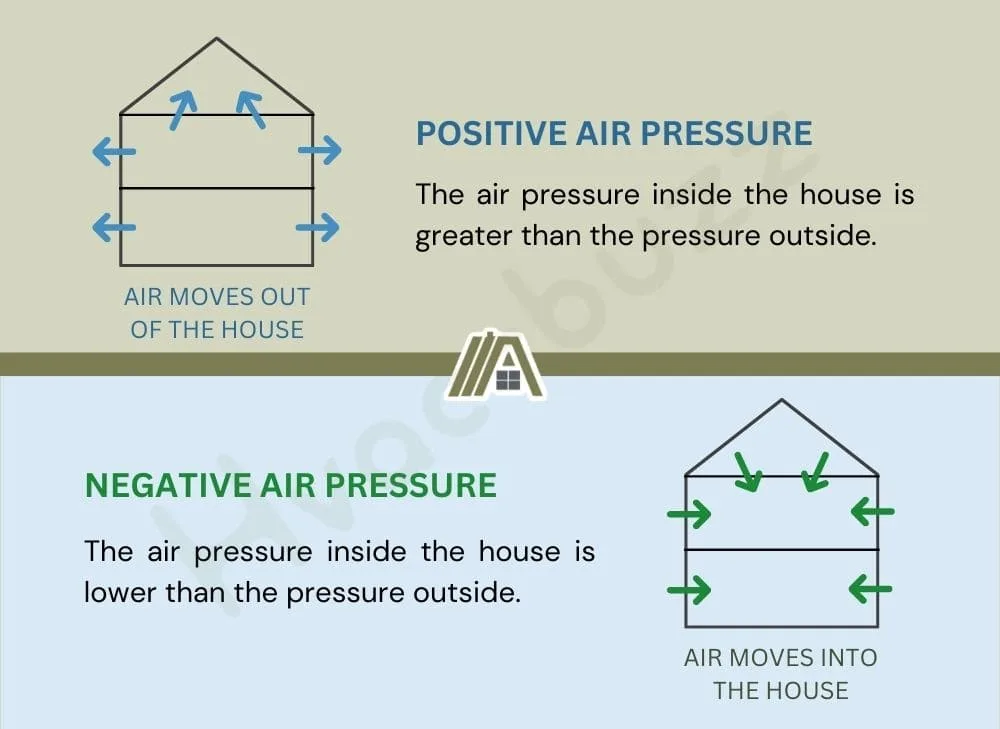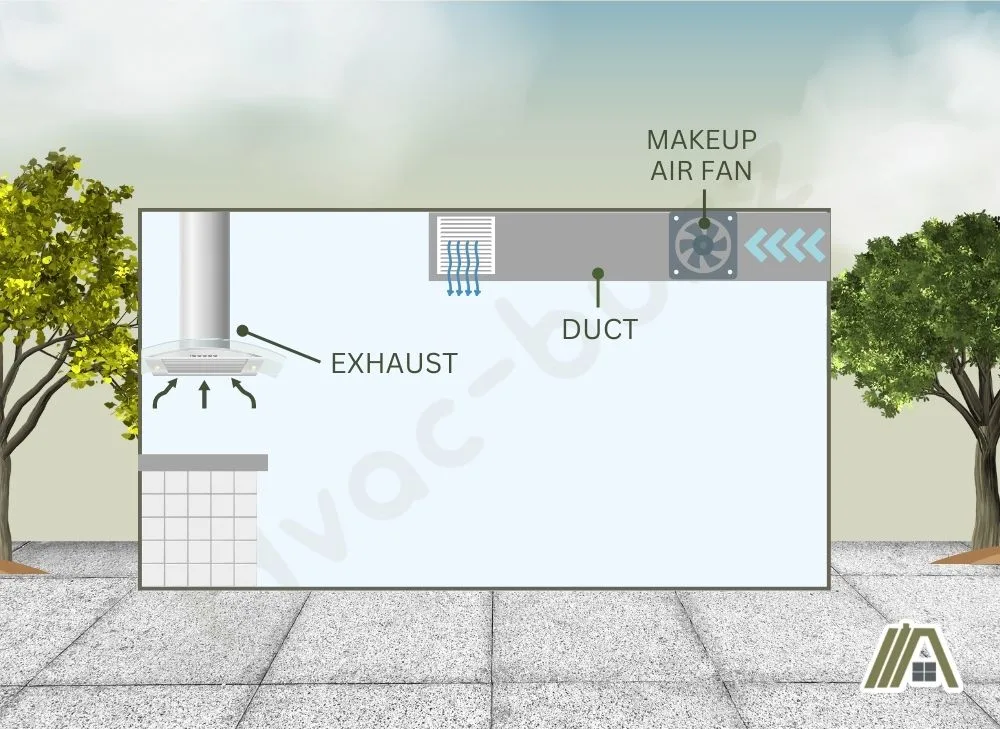While building or remodeling a home, you may have heard the term “makeup air”. Makeup air is associated with some exhaust systems and can be important for the durability and comfort of a home.
However, these systems are not always required. Your exhaust device, room/home size, and ventilation will decide if makeup air is necessary for your project.

Makeup air is most often outside air that is purposefully brought into the home to compensate for air that leaves the home from exhaust devices, such as bathroom fans or range hoods. The purpose of makeup air is to prevent the formation of a negative air pressure system.
What Is Makeup Air?
Makeup air is air pulled from outside to replace the exhausted air from devices such as bathroom fans, range hoods, and vented dryers.
Basically, makeup air fills in the void that’s left by devices that remove air from the home.
This air is usually drawn in actively, but in some cases, it might move inside passively.
Active makeup air usually involves a fan, while passive makeup air does not. Passive makeup air can involve an opening (like a hole) somewhere in the home to allow outside air to flow into the home.

As makeup air units are drawing air into the house, they have to be located a sufficient distance away from the exhaust vents of the systems they are assisting, as well as any other exhaust vent from, say, gas appliances.
At What Point Is Makeup Air Required?
In terms of requirements set out by the International Residential Code, makeup air is required in the following situations:
- In kitchens containing fuel-burning appliances and range hoods with exhaust rates of 400 CFM or more (Makeup Air | When Is It Required for Range Hoods).
- Wherever there are exhaust systems that interfere with the functioning of other appliances (particularly fuel-burning appliances).
- In rooms containing dryers rated at 200 CFM or more or when dryers are installed in closets (Makeup Air | When Is It Required for Dryers).
However, there are other situations in which makeup air is not mandatory, but it is highly recommended. Such situations include:
- Small rooms containing large range hoods (but under 400 CFM) or dryers (but still under 200 CFM).
- Very weathertight rooms containing exhaust systems.
- Houses displaying signs of negative internal pressure.
Whether active or passive, the makeup air system should replace the air at a similar rate that it’s exhausted.
Why the Air Needs to Be Replaced?
When air is actively exhausted from the house—like from a range hood or bathroom fan—it changes the air pressure in the house. This creates a negative air pressure, where there’s greater air pressure outside the house compared to inside.

Normally, the air inside and outside of the house should be equalized. Both positive and negative air pressures are damaging to a home because they push on the home’s walls, roof, doors, and foundation.
Unbalanced pressure can also promote air leaks, which are undesirable no matter which way they are going. Your costly, conditioned air will be tainted with unconditioned outside air coming in through cracks and gaps in the house (negative pressure), or it will be lost to the outdoors (positive pressure).
For a visual demonstration of why makeup air is required, see this video:
The air also needs to be replaced for human health and comfort. Because negative pressure systems draw in air through the path of least resistance, they cause backdrafting.
Backdrafting of fireplaces and gas-burning appliances can expose you to harmful combustion by-products like smoke and carbon monoxide. Backdrafting from drains exposes you to the deeply unpleasant and potentially toxic smell of sewer gas.
Finally, negative indoor pressure is going to prevent the efficient exhausting of subsequent air, making the actual exhaust system ineffective.
Makeup air systems control where the outside air is coming from and can remove strain on the home.
It should be noted that makeup air can also be transfer air, i.e., air that is pulled from another room in the house, but this air would, in turn, need to be replaced with outside air to prevent pressure imbalances in that room.
Why the System Is Often Mechanized?
A makeup air system is often mechanized (that is, active) instead of passive because passive makeup air does not always move fast enough to reset the home’s air pressure to equal the outside air pressure.
In other words, because the air leaving the home is traveling through a mechanized system, it’s easier to maintain a neutral home pressure if the makeup air is also pulled in through a mechanized system.
Additionally, the IRC states that makeup air should enter at approximately the same rate as exhausted air exits.
In some cases, passive air replacement is enough to do the trick, for example, makeup air for a lower CFM exhaust fan in a larger house.
However, powered makeup air systems are usually better because they can be set up to automatically turn on when the related exhaust system turns on.
Also, since passive makeup air usually involves one large or several small openings in the home, it’s less energy efficient as it competes with air conditioning or heating, depending on the season.
Mechanized systems can even be adjusted to the exhaust system so that if you increase the speed of the range hood, the makeup air rate also increases.
How and Where Is Makeup Air Provided?
Makeup air is provided by installing ductwork to connect the outside air with the room containing the exhaust system. Makeup air is usually installed to take air in through the roof or an exterior wall and deliver it to a room through the ceiling or floor.

Depending on the system, makeup air can be heated or cooled to preserve the air temperature of the room it’s entering. There are also systems that connect to the exhaust device so that when the exhaust system is turned on, so is the makeup air system.
Some makeup air kits (like this one for range hoods) are available on the market. Otherwise, you can make your own by purchasing an air intake vent, makeup air fan, and damper (amazon link).
Pressure sensor kits can be added to trigger the makeup air system to equalize the pressure between the inside and outside.
Passive systems usually involve creating openings in the wall to allow air to come in. Again, these are much less energy efficient and slower to equalize pressure differences, but they may be acceptable for somewhere like the bathroom, which is unlikely to need a large makeup air unit.
Sources
https://www.cambridgeair.com/make-up-air
https://www.energyvanguard.com/blog/negative-pressure-causing-problem-your-home/

